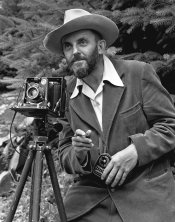Jarin Blaschke
Member
Hi all:
I have slowly been building a 12x20 kit, and have almost everything I need, except a shorter focal length. My eyesight is still very good and combined with my mild OCD, I'm after sharpest performance and most pleasing tonality. I like to fall into a perfect photograph. I can see diffraction after f/64 on my 8x10 chloride contact prints, and I'd like to protect for 4x enlargement for 12x20. In 8x10 I almost always shoot between f/22 and f/45 for maximum sharpness with Apo-Sironar S lenses. Yes, I know that technique is foremost - I work on this all the time. I know that I'll have to get adhesive holders and print with a vacuum frame to see the difference.
For this new format (12x20) I have so far accrued a 600mm Fujinon A and a 750mm Zeiss/Jena Apo-Germinar.
I also purchased a 480 Symmar S, but I found it doesn't quite cover 12x20 due to mechanical vignetting. I'll have to sell or trade toward something else. Three lenses come to mind:
450 Nikkor M - This well regarded lens is reputed to cover 12x20 at my preferred apertures (/22 to /45). However, it's a Tessar, which by reputation has less coverage and less even performance than a plasmat. Any remarks?
480 Apo-Symmar L. My Symmar S from 2 generations prior doesn't cover, but perhaps this later lens does? Obviously very expensive, but I'm happy to wait and save and buy once.
480 Apo-Sironar N? Does this cover? How does it stack up if I'm used to the S series?
Are there any other lenses to consider?
Thanks!
Jarin
I have slowly been building a 12x20 kit, and have almost everything I need, except a shorter focal length. My eyesight is still very good and combined with my mild OCD, I'm after sharpest performance and most pleasing tonality. I like to fall into a perfect photograph. I can see diffraction after f/64 on my 8x10 chloride contact prints, and I'd like to protect for 4x enlargement for 12x20. In 8x10 I almost always shoot between f/22 and f/45 for maximum sharpness with Apo-Sironar S lenses. Yes, I know that technique is foremost - I work on this all the time. I know that I'll have to get adhesive holders and print with a vacuum frame to see the difference.
For this new format (12x20) I have so far accrued a 600mm Fujinon A and a 750mm Zeiss/Jena Apo-Germinar.
I also purchased a 480 Symmar S, but I found it doesn't quite cover 12x20 due to mechanical vignetting. I'll have to sell or trade toward something else. Three lenses come to mind:
450 Nikkor M - This well regarded lens is reputed to cover 12x20 at my preferred apertures (/22 to /45). However, it's a Tessar, which by reputation has less coverage and less even performance than a plasmat. Any remarks?
480 Apo-Symmar L. My Symmar S from 2 generations prior doesn't cover, but perhaps this later lens does? Obviously very expensive, but I'm happy to wait and save and buy once.
480 Apo-Sironar N? Does this cover? How does it stack up if I'm used to the S series?
Are there any other lenses to consider?
Thanks!
Jarin












 (
(
